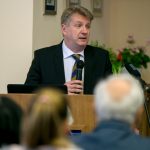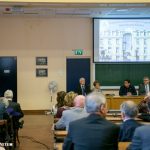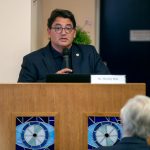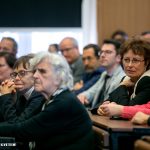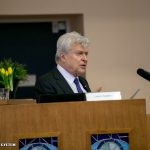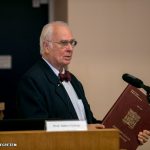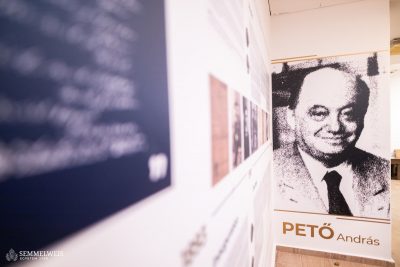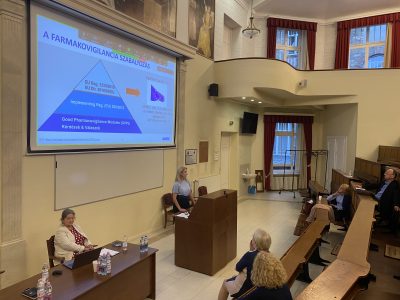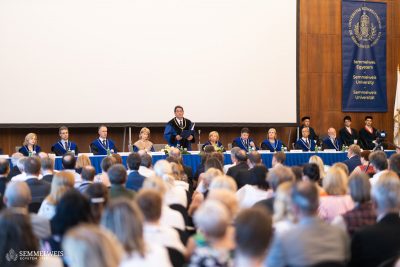A celebration was held on the occasion of the 110th anniversary of the Department of Ophthalmology. Dr. Béla Merkely stated in his welcome that the department is the largest provider of ophthalmic care in the country, which is of outstanding importance in the 250-year history of the university. Dr. Zoltán Zsolt Nagy, director of the department, held a presentation on the history of cataract surgery. A memorial room was created for the occasion, where the portraits of the outstanding figures in Hungarian ophthalmology were displayed and Emil Grósz commemorative coins were awarded.
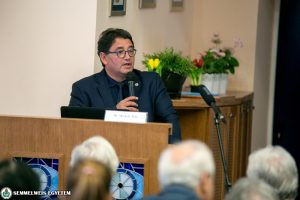 Dr. Béla Merkely recalled: Hungarian ophthalmic care has always been outstanding. Hungary was the first country in the world where ophthalmologists received their own independent department, serving as a “flagship” in the university’s 250-year history. He stated that the department is made up of the merging of two major Hungarian ophthalmology institutions: The Department of Ophthalmology of Tömő Street and the Department of Ophthalmology of Mária Street. This is the largest and most diverse ophthalmic institution in the country, he stressed. He highlighted the FEMTO laser procedure, performed for the first time in the world at the university during a cataract surgery in 2008. Finally, he thanked the institution for its outstanding performance in education and research.
Dr. Béla Merkely recalled: Hungarian ophthalmic care has always been outstanding. Hungary was the first country in the world where ophthalmologists received their own independent department, serving as a “flagship” in the university’s 250-year history. He stated that the department is made up of the merging of two major Hungarian ophthalmology institutions: The Department of Ophthalmology of Tömő Street and the Department of Ophthalmology of Mária Street. This is the largest and most diverse ophthalmic institution in the country, he stressed. He highlighted the FEMTO laser procedure, performed for the first time in the world at the university during a cataract surgery in 2008. Finally, he thanked the institution for its outstanding performance in education and research.
Dr. Zoltán Zsolt Nagy, director of the department presented the history of the Department of Ophthalmology at Mária Street and cataract surgeries. He recalled that in 1801, Hungary was the first country in the world to separate the discipline of ophthalmology from the discipline of surgery, and the Department of Ophthalmology was established, which was then on the third floor of the central building of Üllői út. In 1906, it was decided that the department would receive a separate building. Construction began in 1907 and one year later, in 1908, one of Europe’s most up-to-date ophthalmic department was completed – the director said, adding that in the next decades the Department of Ophthalmology at Mária Street also became a materialized concept. The World War and Revolution made the entire reconstruction of the building unavoidable, and the project was only completed for the 105th anniversary of the clinic at the beginning of the 21st century, he pointed out. This renewed, modern Department of Ophthalmology will provide an opportunity in the next decades to deliver its responsibilities in medical training, patient care and scientific research along with its historical traditions, faithfully and honestly, said Dr. Nagy. He mentioned the former leaders of the department, highlighting his immediate predecessors, Dr. Ildikó Süveges and Dr. János Németh, from whom he learned a great deal.
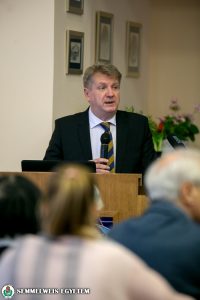 In the remainder of his presentation, Dr. Nagy recalled the changes in cataract treatment from the past to the present. He pointed out that Jacques Daviel is credited with performing the first successful cataract surgery in 1748. In 1939, István Győrffy created the first hard contact lens. He said that in 1953, the first operating microscope was used for ophthalmic surgery. Over the past centuries, enormous development has taken place in the field ophthalmology, which has accelerated over the past 30 years, he pointed out. He explained that today’s modern multifocal lenses can provide the seeing capabilities of a twenty-year-old in the elderly. At the end of his presentation, he introduced how FEMTO laser works today: computer-driven FEMTO laser techniques allow him to perform eye incisions that are seventy times more accurate than ones made with hands. The one-minute intervention does not require anesthetics, and the chance of infection and the chance of complications are much smaller, Dr. Nagy pointed out.
In the remainder of his presentation, Dr. Nagy recalled the changes in cataract treatment from the past to the present. He pointed out that Jacques Daviel is credited with performing the first successful cataract surgery in 1748. In 1939, István Győrffy created the first hard contact lens. He said that in 1953, the first operating microscope was used for ophthalmic surgery. Over the past centuries, enormous development has taken place in the field ophthalmology, which has accelerated over the past 30 years, he pointed out. He explained that today’s modern multifocal lenses can provide the seeing capabilities of a twenty-year-old in the elderly. At the end of his presentation, he introduced how FEMTO laser works today: computer-driven FEMTO laser techniques allow him to perform eye incisions that are seventy times more accurate than ones made with hands. The one-minute intervention does not require anesthetics, and the chance of infection and the chance of complications are much smaller, Dr. Nagy pointed out.
Sándor Lukács, the Kossuth and Príma Primissima Prize-winning actor read an excerpt from Frigyes Karinthy’s novel entitled “A Journey Round My Skull”, which explains how Karinthy’s brain tumor was discovered here at the Department of Ophthalmology. Following the reading, Dr. György Salacz, former director of the department, presented the department’s guestbook and Dr. Judit Sármány spoke about the relationship between music and surgery. The scientific program continued with the awarding of the Emil Grósz commemorative coins. The acknowledgments were received by three members of the department: Dr. Zsuzsanna Récsán, associate professor, Dr. Ágnes Farkas, university professor emerita and Dr. Anna Szamosi, senior lecturer. Four residents of the department received a book award. Attendees were invited to take part in a walking tour, where they could see the memorial room created for the occasion of the anniversary, and look at the illustrated portraits of the outstanding 20 figures of Hungarian ophthalmology.
Bernadett Bóda
Photo: Attila Kovács – Semmelweis University
Translation: Faye Gillespie
